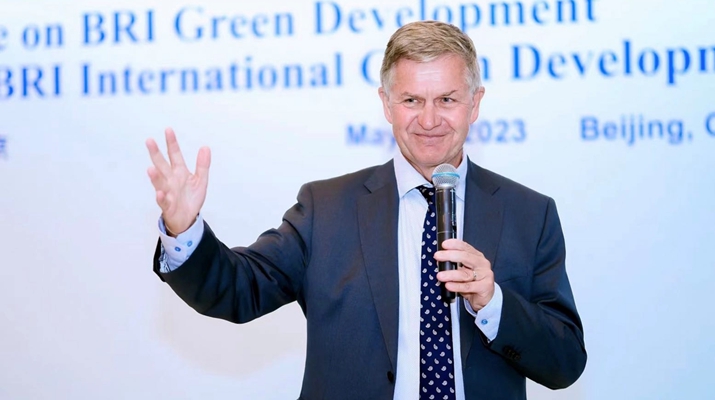
Erik Solheim, former UN Under Secretary General and President of the Green Belt and Road Institute, has noticed a significant power shift in global climate action over the past decade. Drawing from an extensive career dedicated to environmental protection, he is examining the emergence of a new landscape in environmental geopolitics, with China rising as a global green leader. In an exclusive interview with Beijing Review reporters Peng Jiawei and Li Xiaoyang, Solheim shared his views on China’s changing development strategies, as well as its evolving role in global environmental governance. Edited excerpts from Solheim's remarks follow:
From speed to sustainability
It may be very difficult for young Chinese to imagine. But back in 1984, when I visited China for the first time, there were no skyscrapers, few private cars and only one metro line in China’s mainland.
It was a time when China was still in the early stage of reform and opening up and actively explored its own path toward modernization.The entire focus was on economic development and creating a huge middle class. And it succeeded in all these endeavors. China has miraculously brought more people out of poverty than any nation inhuman history at a massive scale and an unprecedented speed. A fantastic achievement indeed.
But it came with a heavy price—pollution. In the early days of economic reform, there was very little concern for nature. And when I spoke to Chinese people during the Beijing Summer Olympics in 2008, I would commend them for how affluent they were compared to their parents or grandparents. But people would always reply, “Yes, but I want to see the Sun,” or “I don’t want to inhale the smoke.”
That was true 15 years ago. However, over the past decade, things have completely turned around.There has been a shift of focus in China from growth to high-quality growth, from speed, numbers and high-rises to environmental protection and personal wellbeing.
The shift was powered mainly by three factors.First and foremost was an increased public awareness of environmental protection. Next, you need a clear-eyed political leadership determined to promote sustainability. Last but not least, you need to see it as a business opportunity, because only businesses can bring the transformation to scale.It started with a nationwide war on pollution. But now, the country’s green development has evolved to a point where it is not just about cleansing theair and the water, but also about mitigating climate change, transitioning to renewable energy and protecting biodiversity.
Taking the lead
No one can copy another country’s environmental strategies, but we can all learn. Ten years ago,Europe was very much in the lead in everything climate-related. If anyone back in those days asked me where to go for best green practices, I would always say Brussels, Berlin and Paris. But now, Chinese cities have surpassed Europe in all these regards.
China is well ahead of Europe when it comes to green technologies. The country possesses about 60 percent of the green technology used worldwide. Some 80 to 90 percent of solar power in the world is produced in China.
What is often overlooked, but worth noticing, is that China is also leading a global revolution on ecological conservation.I especially recommend countries seeking sustainable solutions to look toward south China, where many of the country’s most industrially developed and densely populated cities are clustered around the Yangtze River Delta and the Pearl River Delta.
These industrial hubs are the most difficult areas in which to practice green strategies. But China has managed to reimagine these cities as complex ecosystems where the urban landscapes, nature and human communities come together to create sustainable urban spaces.This is something that other parts of the world can learn from.
One example is Xiamen, a coastal city in the southeastern province of Fujian. I visited the place in April last year. It is not as globally renowned as Shanghai and Beijing, but I have to say I was not aware that it was such a beautiful,modern and livable city.
I was invited to work with a group of researchers at Xiamen University on the theme of ocean pollution. And I was really impressed by the university, which I think is arguably the most beautiful university I have ever seen. It has a huge botanical garden, a mixture of ancient architectures and modern complexes, a fantastic view of the ocean, and an enormous expanse of green plantation.
An 18-minute drive from the university is Yundang Lake, which was once a harbor connected to the sea. If you travel some decades back to the 1970s, when the city was reclaiming land from the sea,the lake became an inner lake into which tons of untreated sewage and industrial wastes were discharged.
Starting in the mid-1980s, efforts were made to return the lake to its former state. The city has been committed to cleansing the pollution and protecting the mangrove-dotted islands in the middle of the lake, where thousands of egrets now reside.
Today, it stands as a beautiful lake and a wonderful example of how polluted water bodies can be fully restored.
Apart from repairing the damaged ecosystems in urban areas, China has also been committed to building a national park system to protect wildlife and natural landscapes.The concept of national parks is an American innovation. Former U.S. President Theodore Roosevelt once said that there is nothing as American as a national park. But China is now taking the lead by creating one of the world’s biggest national park systems, which not only covers its vast and less populated west, but also the entire country.

Nuorilang Waterfall in the Jiuzhaigou National Park in Sichuan Province on June 5, 2019 (XINHUA)
Cooperation vs. competition
Competition has long been regarded as an obstacle to achieving environmental goals. But the truth is,we need competition as much as cooperation.
Take electric vehicles (EVs) as an example. Chinese EV companies are expanding into global markets at an astounding pace,with BYD at the head of the pack.Their rise as new formidable competitors sent a sobering message to Volkswagen, General Motors,Toyota and other traditional automakers, pushing them to speedup their own EV development. In that sense, competition can act as catalysts to the global transition to clean energy.
But we also need cooperation and shared rules so that we can all benefit from fair competition.
Every nation in the world wants to protect its own vital economic interests, such as local employment and domestic industries. While venturing abroad into new markets,Chinese companies should also step up investment in the creation of overseas manufacturing hubs. BYD,for example, has started building anEV factory in Brazil. The project not only powers BYD’s globalization drive, but also creates job opportunities and fosters local industries.
In today’s world, collaboration is a necessity. The United States wishes to accelerate the growth of its solar power sector. However,there’s no way it can do so without cooperating with China, as the latter is the largest producer of solar panels in the world.
Therefore, we should facilitate dialogue between government authorities and businesses in China and those in other parts of the world, so that fair competition can take us all to a net-zero future much faster.

A train runs on the Chinese-built Addis Ababa-Djibouti Railway during an operational test nearAddis Ababa, Ethiopia, on October 13, 2016 (XINHUA)
From brown partnerships to green investment
There has been an absolute sea change in China’s outbound investment, which refects a broader repositioning of China around global energy projects.
In the early days of the Belt and Road Initiative [proposed by China in 2013 to boost connectivity along and beyond the ancient Silk Road routes], China was engaged in a number of “brown” projects—projects that aim to help participating countries build infrastructure for oil, gas and coal. In September 2021, Chinese President Xi Jinping told the UN General Assembly that China would not build new coal fired power projects abroad. Two years on, the initiative has become one of the main vehicles for global green investment.
What this means is that China has started pouring investment into solar and wind power projects in Ethiopia, Kenya, Viet Nam and Indonesia. China and Indonesia, for instance, have recently agreed on a $54-billion deal that directs Chinese investment toward solar energy production in Indonesia.As the fourth most populous country in the world,Indonesia has to grapple with a colossal demand for energy. So the deal matters a lot.
China is also committed to building green public transport along the Belt and Road routes. Examples include the China-Laos Railway, the Mombasa-Nairobi Standard Gauge Railway in Kenya, the Addis Ababa-Djibouti Railway in the Horn of Africa, and, most recently, the Jakarta-Bandung High-Speed Rail in Indonesia.
Green operation is a common thread running through these railway projects, which were all carefully designed to minimize their impact on the environment. These new rail lines will also drive economic development along the routes by generating jobs for the local workforce and increasing trade and connectivity.
From linear to circular
If you ask me for one area in which China can improve, I would really encourage a more circular economy. This is a task that needs to be tackled by not only China but also the entire world.
At present, 99 percent of all clothes made on this planet are just thrown away. But we can start recycling the cotton in these clothes. They’re experimenting with the circular use of textiles in Bangladesh. But that is not enough. Other countries should all join the action.
Digital devices are evolving at an increasingly rapid pace. In the eternal chase for the latest technologies, we are used to frequently buying new phones, while leaving our old phones to rust on our shelves. In a circular economy,however, nothing in these digital products cannot be recycled.
If we invest efforts in these small things in life, we won’t need to extract resources from nature as much as we do now. The advance into a circular economy, in which all electronic wastes, plastics and clothes are recycled, holds enormous opportunities. And I think Chinese companies, like they always have in the past, can lead the world in the race toward a circular future.
Copyedited by G.P. Wilson
Comments to pengjiawei@cicgamericas.com